ISSN : 2393-8854
Global Journal of Research and Review
Some Operations and Properties of Neutrosophic Cubic Soft Set
Pramanik S1*, Dalapati S2, Alam S2 and Roy TK2
1Department of Mathematics, Nandalal Ghosh B.T. College, Panpur, West Bengal, India
2Department of Mathematics, Indian Institute of Engineering Science and Technology, Shibpur, West Bengal, India
- *Corresponding Author:
- Surapati Pramanik
Department of Mathematics, Nandalal Ghosh B.T. College
Panpur, Narayanpur, North 24 Parganas-743126
West Bengal, India
Tel: 0332580 1826
E-mail: sura_pati@yahoo.co.in
Received Date: April 01, 2017; Accepted Date: April 21, 2017; Published Date: April 30, 2017
Citation: Pramanik S, Dalapati S, Alam S, et al. Some Operations and Properties of Neutrosophic Cubic Soft Set. Glob J Res Rev. 2017, 4:2.
Abstract
In this paper we define some operations such as P-union, P-intersection, R-union, R-intersection for neutrosophic cubic soft sets (NCSSs). We prove some theorems on neutrosophic cubic soft sets. We also discuss various approaches of Internal Neutrosophic Cubic Soft Sets (INCSSs) and external neutrosophic cubic soft sets (ENCSSs). We also investigate some of their properties.
Keywords
Neutrosophic cubic soft set; Neutrosophic soft set; Cubic set; Internal neutrosophic Cubic soft set; External neutrosophic cubic soft set
Introduction
Neutrosophic set [1] grounded by Smarandache in 1998, is the generalization of fuzzy set [2] introduced by Zadeh in 1965 and intuitionistic fuzzy set [3] by Atanassov in 1983. In 1999, Molodstov [4] introduced the soft set theory to overcome the inadequate of existing theory related to uncertainties. Soft set theory is free from the parameterization inadequacy syndrome of fuzzy set theory [2], rough set theory [5], probability theory for dealing with uncertainty. The concept of soft set theory penetrates in many directions such as fuzzy soft set [6-9], intuitionistic fuzzy soft set [10-13], interval valued intuitionistic fuzzy soft set [14], neutrosophic soft set [15-18], interval neutrosophic set [19,20]. In 2012, Jun et al. [21] introduced cubic set combining fuzzy set and interval valued fuzzy set. Jun et al. [21] also defined internal cubic set, external cubic set, P-union, R-union, P-intersection and R-intersection of cubic sets, and investigated several related properties. Cubic set theory is applied to CI-algebras [22], B-algebras [23], BCK/BCI-algebras [24,25], KU-Algebras ([26,27], and semi-groups [28]. Using fuzzy set and interval-valued fuzzy set Abdullah et al. [29] proposed the notion of cubic soft set [29] and defined internal cubic soft set, external cubic soft set, P-union, R-union, P-intersection and R-intersection of cubic soft sets, and investigated several related properties. Ali et al. [30] studied generalized cubic soft sets and their applications to algebraic structures. Wang et al. [31] introduced the concept of interval neutrosophic set. In 2016, Ali et al. [32] presented the concept of neutrosophic cubic set by combining the concept of neutrosophic set and interval neutrosophic set. Ali et al. [32] mentioned that neutrosophic cubic set is basically the generalization of cubic set. Ali et al. [32] also defined some new type of internal neutrosophic cubic set (INCSs) and external neutrosophic cubic set (ENCSs) namely,  . Ali et al. [32] also presented a numerical problem for pattern recognition. Jun et al. [33] also studied neutrosophic cubic set and proved some properties. In 2016, Chinnadurai et al. [34] introduced the neutrosophic cubic soft sets and proved some properties.
. Ali et al. [32] also presented a numerical problem for pattern recognition. Jun et al. [33] also studied neutrosophic cubic set and proved some properties. In 2016, Chinnadurai et al. [34] introduced the neutrosophic cubic soft sets and proved some properties.
In this paper we discuss some new operations and new approach of internal and external neutrosophic cubic soft sets, and P-union, R-union, P-intersection, R-intersection. We also prove some theorems related to neutrosophic cubic soft sets.
Rest of the paper is presented as follows. Section 2 presents some basic definition of neutrosophic sets, interval-valued neutrosophic sets, soft sets, cubic set, neutrosophic cubic sets and their basic operation. Section 3 is devoted to presents some new theorems related to neutrosophic cubic soft sets. Section 4 presents conclusions and future scope of research.
Preliminaries
In this section, we recall some well-established definitions and properties which are related to the present study.
Definition 1: Neutrosophic set [1]
Let U be the space of points with generic element in U denoted by u. A neutrosophic set λ in U is defined as λ={<u, tλ (u), iλ (u), fλ (u)>:u∈U} , where tλ (u):U →]- 0, 1+ [,iλ (u):U →]- 0, 1+ [, and fλ (u):U →]- 0, 1+ [ and − 0 ≤ tλ (u)+ iλ (u)+fλ (u) ≤3+.
Definition 2: Interval value neutrosophic set [31]
Let U be the space of points with generic element in U denoted by u. An interval neutrosophic set A in U is characterized by truthmembership function tA, the indeterminacy function iA and falsity membership function fA. For each u∈U, tA (u), iA (u), fA (u) ⊆ [0, 1] and A is defined as
A={<u, [ t+A (u), t+A (u)], [ i−A (u), i+A (u)], [ f−A (u), f+A (u)]:u∈U}.
Definition 3: Neutrosophic cubic set [32]
Let U be the space of points with generic element in U denoted by u∈U. A neutrosophic cubic set in U defined as  ={< u, A (u), λ (u) >: u∈U} in which A (u) is the interval valued neutrosophic set and λ(u) is the neutrosophic set in U. A neutrosophic cubic set in U denoted by
={< u, A (u), λ (u) >: u∈U} in which A (u) is the interval valued neutrosophic set and λ(u) is the neutrosophic set in U. A neutrosophic cubic set in U denoted by  = <A, λ>. We use C
= <A, λ>. We use C (U) as a notation which implies that collection of all neutrosophic cubic sets in U.
(U) as a notation which implies that collection of all neutrosophic cubic sets in U.
Definition 4: Soft set [4]
Let U be the initial universe set and E be the set of parameters. Then soft set FK over U is defined by FK ={< u, F (e)>: e ∈ K, F (e) ∈P (U)}
Where F: K → P (U), P (U) is the power set of U and K ⊂ E.
Definition 5: Neutrosophic cubic soft set [34]
A soft set  is said to be neutrosophic cubic soft set iff
is said to be neutrosophic cubic soft set iff  is the mapping from K to the set of all neutrosophic cubic sets in U (i.e., C
is the mapping from K to the set of all neutrosophic cubic sets in U (i.e., C (U) ).
(U) ).
i.e.  : K→C
: K→C (U) , where K is any subset of parameter set E and U is the initial universe set.
(U) , where K is any subset of parameter set E and U is the initial universe set.
Neutrosophic cubic soft set is defined by

Where, A(ei) is the interval valued neutrosophic soft set and λ(ei) is the neutrosophic soft set.
Definition: Internal neutrosophic cubic soft set (INCSS)
A neutrosophic cubic soft set  is said to be INCSS if for all ei∈ K E
is said to be INCSS if for all ei∈ K E

Definition: External neutrosophic cubic soft set (ENCSS)
A neutrosophic cubic soft set  is said to be ENCSS if for all ei∈ K E
is said to be ENCSS if for all ei∈ K E
 ,
,

Some theorem related to these topics
Theorem 1
Let  be a neutrosophic cubic soft set in U which is not an ENCSS. Then there exists at least one ei ∈ K ⊆ E for which there exists some u∈U such that
be a neutrosophic cubic soft set in U which is not an ENCSS. Then there exists at least one ei ∈ K ⊆ E for which there exists some u∈U such that

Proof
From the definition of ENCSSs, we have

 , for all u∈U, corresponding to each ei∈ K ⊆ E.
, for all u∈U, corresponding to each ei∈ K ⊆ E.
But given that  is not an ENCSS, so at least one ei ∈ K ⊆ E.
is not an ENCSS, so at least one ei ∈ K ⊆ E.
There exists some u∈U such that  ,
,  . Hence the proof is complete.
. Hence the proof is complete.
Theorem 2
Let  be a NCSS in U. If
be a NCSS in U. If  is both an INCSS and ENCSS in U for all u∈U, corresponding to each ei ∈ K, then,
is both an INCSS and ENCSS in U for all u∈U, corresponding to each ei ∈ K, then,  ,
,  ,where
,where

Proof
Suppose  be both an INCSS and ENCSS corresponding to each ei ∈ K and for all u∈U. We have
be both an INCSS and ENCSS corresponding to each ei ∈ K and for all u∈U. We have  ,
,  ,
,  ,
,
Again by definition of ENCSS corresponding to each ei K ∈ and for all u∈U, we have
 ,
,  ,
, 
Since  is both an ENCSS and INCSS, so only possibility is that,
is both an ENCSS and INCSS, so only possibility is that,  ,
, 
Hence proved.
Definition
Let  be two neutrosophic cubic soft sets in U and K1, K2 be any two subsets of K. Then, we define the following:
be two neutrosophic cubic soft sets in U and K1, K2 be any two subsets of K. Then, we define the following:
1. 
2. If and
and  are two NCSSs then we define P- order as
are two NCSSs then we define P- order as iff the following conditions are satisfied:
iff the following conditions are satisfied:
i. K1 ⊆ K2, and
ii. 
A(ei) B(ei) and 1 (e ) 2 (e ) u U ⊆ λ ⊆λ ∀ ∈ corresponding to each
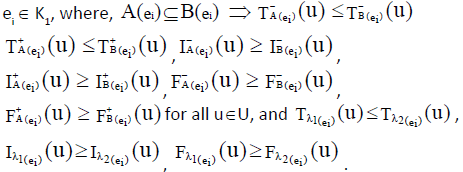
3. If  are two neutrosophic cubic soft sets, then we
are two neutrosophic cubic soft sets, then we
define the R-order as  iff the following conditions are satisfied:
iff the following conditions are satisfied:
i. K1 ⊆ K2 and
ii.  for all ei ∈ K1 iff
for all ei ∈ K1 iff  corresponding to each ei ∈ K1.
corresponding to each ei ∈ K1.
Definition
Let  be two NCSSs in U and K1, K2 be any two subsets of parameter set K. Then we define P-union as
be two NCSSs in U and K1, K2 be any two subsets of parameter set K. Then we define P-union as  , where K3 ∈ K1∪ K2,
, where K3 ∈ K1∪ K2,
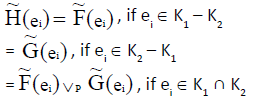
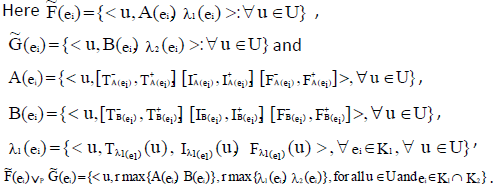
Definition
Let  be two NCSSs in U and K1, K2 be any two subsets of parameter set K. The P-intersection of
be two NCSSs in U and K1, K2 be any two subsets of parameter set K. The P-intersection of  is denoted by
is denoted by  where
where  and
and  defined as
defined as =
=
Here, 
Definition: Compliment
The compliment of  denoted by
denoted by  is defined by
is defined by

Where,

Some properties of P-union and P-intersection

Proof 1:
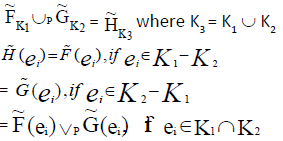
Here,
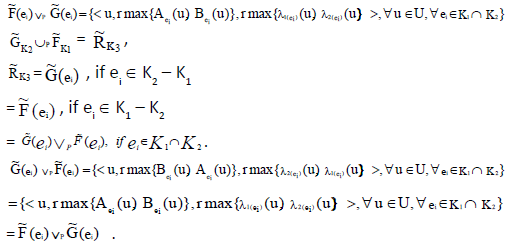
Hence the proof.
Proof 2:
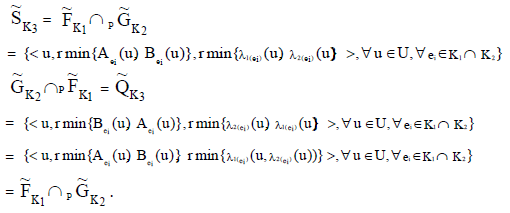
Hence the proof.
Definition: R-union and R-intersection
Let  be two NCSSs over U. Then R-union is denoted as
be two NCSSs over U. Then R-union is denoted as  , where K3 = K1∪ K2 and
, where K3 = K1∪ K2 and  . Then R-union is defined as
. Then R-union is defined as

Here  defined as
defined as

R-intersection is denoted as 
K2.Then R-intersection is defined as:

Theorem 3
Let U be the initial universe and I, J, L, S any four subsets of E, then for four corresponding neutrosophic cubic soft sets  the following properties hold
the following properties hold

Proof:
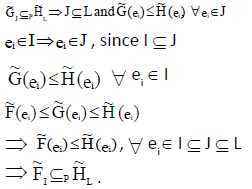
Hence the proof.
ii. 
Proof: If 
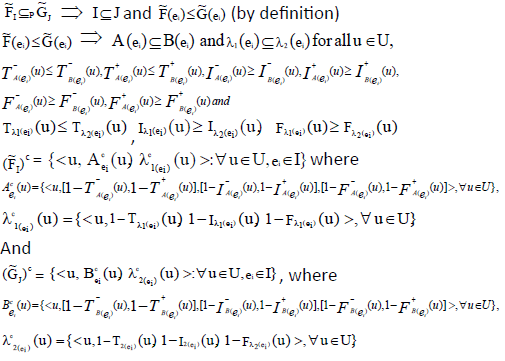
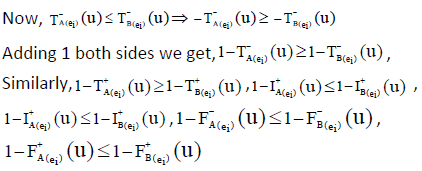 (1)
(1)
 (2)
(2)
Hence the proof.
Theorem 4
Let  be a NCSS over U,
be a NCSS over U,
If  is an INCSS then
is an INCSS then  is also an INCSS.
is also an INCSS.
If  is an ENCSS then
is an ENCSS then  is also an ENCSS.
is also an ENCSS.
Proof
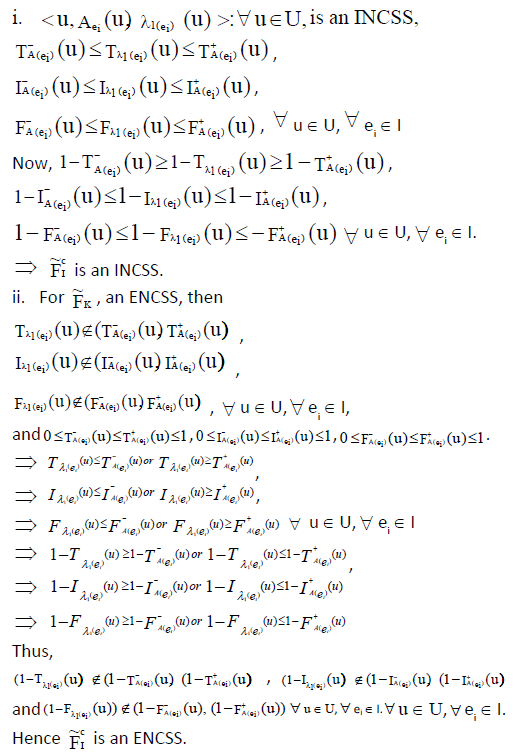
Theorem 5
Let  and
and  be any two INCSSs then
be any two INCSSs then
 is an INCSS.
is an INCSS.
 is an INCSS.
is an INCSS.
Proof
Since  are INCSSs, so for
are INCSSs, so for  we have
we have

Also for  we have
we have
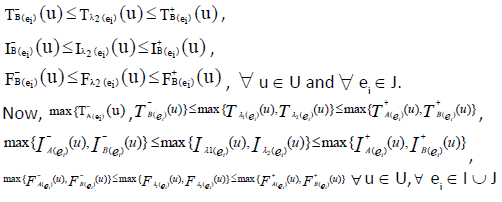
Now by the definition of P-union  is an INCSS.
is an INCSS.

ii. Now,  and by definition,
and by definition,
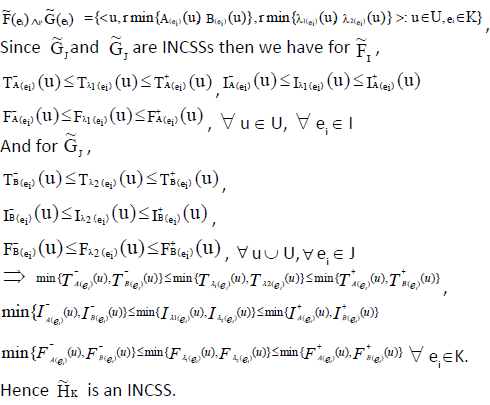
Theorem 6
Let  be any two INCSSs over U having the conditions:
be any two INCSSs over U having the conditions:

Proof
Since  are INCSSs in U.
are INCSSs in U.
So for  , we have
, we have

Also for  we have
we have
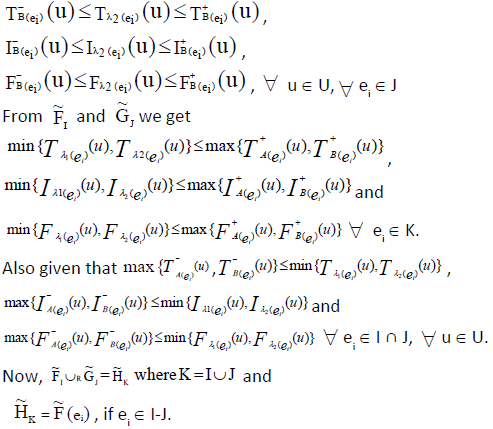

Since  are INCSSs so from the given condition and definition of INCSS we can write,
are INCSSs so from the given condition and definition of INCSS we can write,

If ei ∈ I - J or ei ∈ J - I then, the result is trivial.
Thus  is an INCSS.
is an INCSS.
Theorem 7
Let  be any two INCSSs over U satisfying the condition:
be any two INCSSs over U satisfying the condition: 
Then  is an INCSS.
is an INCSS.
Proof
Since  are INCSSs in U,
are INCSSs in U,
we have,  and
and 
Also for  we have,
we have,  ,
,  and
and 


defined as

Given condition that 
 Thus from given condition and definition of INCSSs
Thus from given condition and definition of INCSSs

Hence  is an INCSS.
is an INCSS.
Theorem 8
Let  be any two ENCSSs then
be any two ENCSSs then

Proof
Since  and are ENCSSs, we have
and are ENCSSs, we have



Now by definition of P-union,  .
.

Here  defined as
defined as

Thus 
For ei ∈ I - J or ei ∈ J - I these results are trivial.
Hence the proof.
ii. Since  are ENCSSs, then
are ENCSSs, then

and 



we have

Here  defined as
defined as

Thus  is an ENCSS.
is an ENCSS.
Theorem 9
Let  be any two INCSSs in U such that
be any two INCSSs in U such that

Proof:
Since  are INCSSs in U.
are INCSSs in U.
we have, 
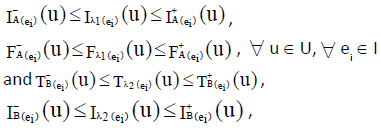
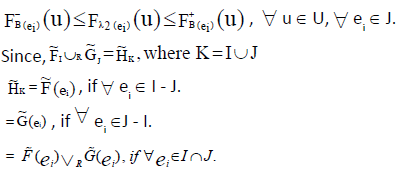

Definition
Let  and
and  are two NCSSs in U. We defined new NCSSs by interchanging the neutrosophic part of the two NCSSs. We denoted its by
are two NCSSs in U. We defined new NCSSs by interchanging the neutrosophic part of the two NCSSs. We denoted its by  and defined by
and defined by ,
,  respectively.
respectively.
Theorem 10
 are ENCSSs and
are ENCSSs and are INCSSs in U. Then
are INCSSs in U. Then is an INCSS in U.
is an INCSS in U.
Proof
Since  and
and  are ENCSSs,
are ENCSSs,
we have
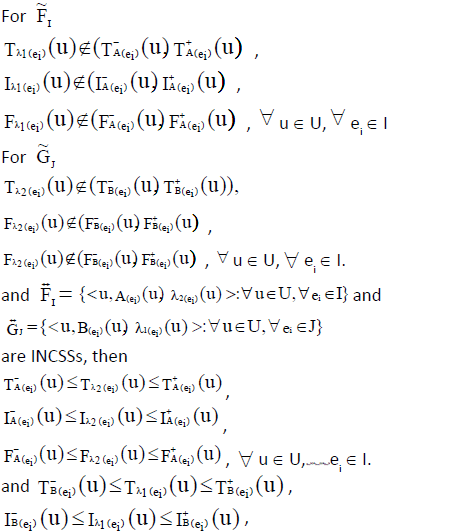
 By the definition of ENCSSs and INCSSs all the possibility are as under:
By the definition of ENCSSs and INCSSs all the possibility are as under:
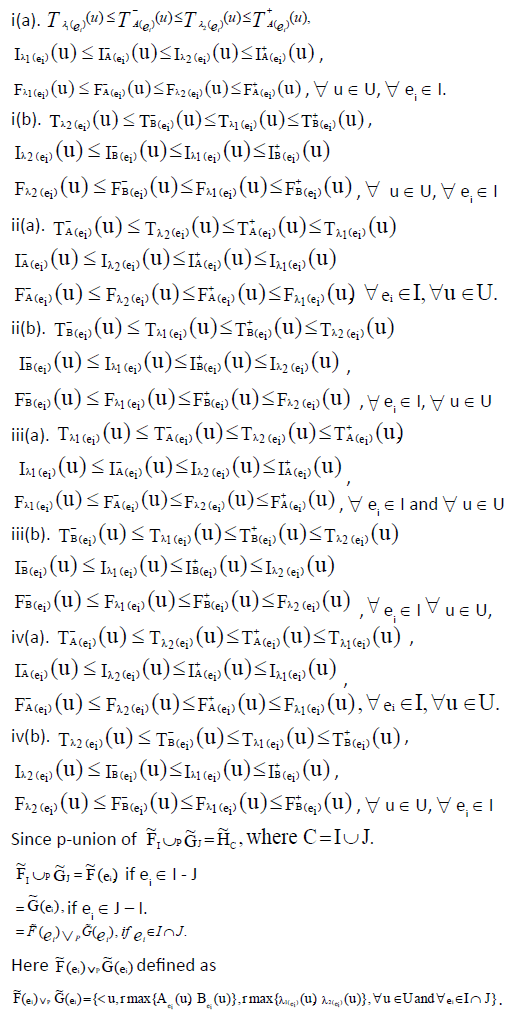
Case 1
If  then from i(a)., and ii(a). We have
then from i(a)., and ii(a). We have
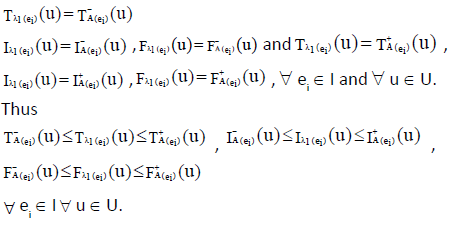
Case 2
 then from i(b) and ii(b). , we have
then from i(b) and ii(b). , we have
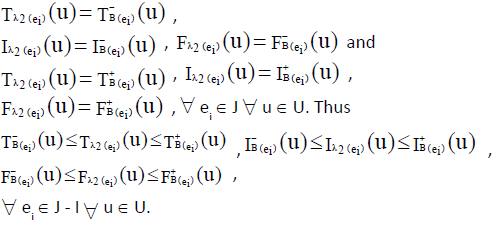
Case 3
 , then from i(a) and i(b)., we have
, then from i(a) and i(b)., we have
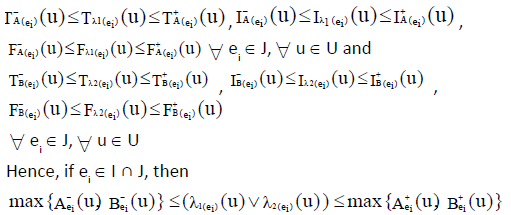
in all the three cases.
 is an INCSS in U.
is an INCSS in U.
Conclusion
In this paper we have defined some operations such as P-union, P-intersection, R-union, R-intersection for neutrosophic cubic soft sets. We have also defined some operation of INCSSs and ENCSSs. We have proved some theorems on INCSSs and ENCSSs. We have discussed various approaches INCSSs and ENCSSs. We hope that proposed theorems and operations will be helpful to multi attribute group decision making problems in neutrosophic cubic soft set environment.
References
- Smaramdache F (1998) A unifying field in logics. neutrosophy: Neutrosophic probability set and logic. Rehoboth: American research press.
- Zadeh LA (1965) Fuzzy sets. Information and Control 8: 338-353.
- Atanassov KT (1986) Intuitionistic fuzzy sets. Fuzzy Sets and Systems 20: 87-96.
- Molodtsov DA (1999) Soft set theory-first results. Computers and Mathematics with Applications37: 19-31.
- Pawlak Z (1982) Rough sets. International journal of information and computer sciences 11: 341-356.
- Agman NC, Deli I (2012) Means of FP-soft sets and its applications. Hacettepe Journal of Mathematics and Statistics 41: 615-625.
- Agman NC, Deli I (2012) Product of FP-soft sets and its applications. Hacettepe Journal of Mathematics and Statistics 41: 365-374.
- Feng Q, Zheng W (2014) New similarity measures of fuzzy soft sets based on distance measures. Annals of Fuzzy Mathematics and Informatics 7: 669-686.
- Maji PK, Biswas R, Roy AR (2001) Fuzzy soft sets. Journal of Fuzzy Mathematics 9:589-602.
- Bora M, Bora B, Neog TJ, Sut DK(2014) Intuitionistic fuzzy soft matrix theory and it' s application in medical diagnosis. Annals of Fuzzy Mathematics and Informatics 7: 143-153.
- Jiang Y, Tang Y, Chen Q(2011) An adjustable approach to intuitionistic fuzzy soft sets based decision making. Applied Mathematical Modelling 35: 824-836.
- Maji PK, Biswas R, Roy AR (2004) On Intuitionistic fuzzy soft sets. The journal of Fuzzy Mathematics 12: 669-683.
- Yang YW, Qian T (2013) Decision-making approach with entropy weight based on intuitionistic fuzzy soft set. Annals of Fuzzy Mathematics and Informatics 6: 415-424.
- Mukherjee A, Saha A (2013) Interval-valued intuitionistic fuzzy soft rough sets. Annals of Fuzzy Mathematics and Informatics 5: 533-547.
- Broumi S, Deli I, Smarandache F (2014) Neutrosophic Parameterized Soft Set Theory and Its Decision Making. International Frontier Science Letters 1: 1-11.
- Deli I, Toktas Y, Broumi S (2014) Neutrosophic Parameterized Soft Relations and Their Applications. Neutrosophic Sets and Systems 4: 25-34.
- Maji PK (2013) Neutrosophic soft set. Annals of fuzzy mathematics and informatics 5: 157-168.
- Maji PK (2012) A neutrosophic soft set approach to a decision making problem. Annals of Fuzzy Mathematics and Informatics 3: 313-319.
- Broumi S, Deli I, Smarandache (2014) Relations on interval valued neutrosophic soft sets. Journal of New Results in Science 5: 01-20.
- Broumi S, Deli I, Smarandache (2014) Distance and similarity measures of interval neutrosophic soft sets. Critical Review 8: 14-31.
- Jun YB, Kim CS, Yang KO (2012) Cubic sets. Annal of Fuzzy Mathematics and Informatics 4: 83-98.
- Ahn SS, Kim YH, Ko JM (2014) Cubic subalgebras and filters of CI-algebras. Honam Mathematical Journal 36: 43-54.
- Senapati T, Kim CS, Bhowmik M, Pal M (2015) Cubic subalgebras and cubic closed ideals of B-algebras. Fuzzy Information and Engineering 7: 129-149.
- Jun YB, Lee KJ (2010) Closed cubic ideals and cubic subalgebras in BCK/BCI-algebras. Applied Mathematical Sciences 4: 65-68.
- Jun YB, Lee KJ, Kang MS (2011) Cubic structures applied to ideals of BCI-algebras. Computers & Mathematics with Applications62: 3334-3342.
- Akram M, Yaqoob N, Gulistan M (2013) Cubic KU-subalgebras. International Journal of Pure and Applied Mathematics 89: 659-665.
- Yaqoob N, Mostafa SM, Ansari MA (2013) On cubic KU-ideals of KU-algebras. ISRN Algebra Art.
- Jun YB, Khan A (2013) Cubic ideals in semigroups. Honam Mathematical Journal 35: 607-623.
- Abdullah S, Khan I, Aslam M (2012) A new approach to soft set through applications of cubic set.
- Ali A, Jun YB, Khan M, Shi FG, Anis S (2015) Generalized cubic soft sets and their applications to algebraic structures. Italian Journal of Pure and Applied Mathematics 35: 393-414.
- Wang H, Smarandache F, Zhang YQ, Sunderraman R (2005) Interval Neutrosophic Sets and logic: Theory and Applications in Computing. Hexis, Neutrosophic book series.
- Ali M, Deli I, Smarandache F (2016) The theory of neutrosophic cubic sets and their applications in pattern recognition. Journal of Intelligent and Fuzzy Systems 30: 1957-1963.
- Jun YB, Smarandache F, Kim CS (2017) Neutrosophic cubic sets.New Mathematics and Natural Computation 13: 41-54.
- Chinnadurai V, Swaminathan A, Anu B (2016) Some properties of Neutrosophic cubic soft set. International Journal of Computational Research and Development 1: 113-119.
Open Access Journals
- Aquaculture & Veterinary Science
- Chemistry & Chemical Sciences
- Clinical Sciences
- Engineering
- General Science
- Genetics & Molecular Biology
- Health Care & Nursing
- Immunology & Microbiology
- Materials Science
- Mathematics & Physics
- Medical Sciences
- Neurology & Psychiatry
- Oncology & Cancer Science
- Pharmaceutical Sciences
